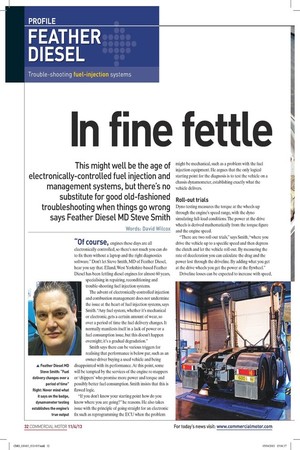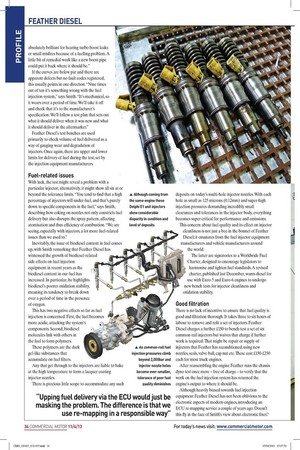In fine fettle This might well be the age of
Page 23

Page 24

Page 25

Page 26

If you've noticed an error in this article please click here to report it so we can fix it.
electronically-controlled fuel injection and management systems, but there's no substitute for good old-fashioned troubleshooting when things go wrong says Feather Diesel MD Steve Smith Words: David Wilcox Ofcourse, engines these days are all electronically controlled, so there's not much you can do to fix them without a laptop and the right diagnostics software." Don't let Steve Smith, MD of Feather Diesel, hear you say that. Elland, West Yorkshire-based Feather Diesel has been fettling diesel engines for almost 60 years, specialising in repairing, reconditioning and trouble-shooting fuel injection systems.
The advent of electronically-controlled injection and combustion management does not undermine the issue at the heart of fuel injection systems, says Smith. "Any fuel system, whether it's mechanical or electronic, gets a certain amount of wear, so over a period of time the fuel delivery changes. It normally manifests itself in a lack of power or a fuel consumption issue, but this doesn't happen overnight; it's a gradual degradation."
Smith says there can be various triggers for realising that performance is below par, such as an owner-driver buying a used vehicle and being disappointed with its performance. At this point, some will be tempted by the services of the engine re-mappers or 'chippers' who promise more power and torque and possibly better fuel consumption. Smith insists that this is flawed logic.
"If you don't know your starting point how do you know where you are going?" he reasons. He also takes issue with the principle of going straight for an electronic fix such as reprogramming the ECU when the problem might be mechanical, such as a problem with the fuel injection equipment. He argues that the only logical starting point for the diagnosis is to test the vehicle on a chassis dynamometer, establishing exactly what the vehicle delivers.
Roll-out trials Dyno testing measures the torque at the wheels up through the engine's speed range, with the dyno simulating full-load conditions. The power at the drive wheels is derived mathematically from the torque figure and the engine speed.
"There are two roll-out trials," says Smith, "where you drive the vehicle up to a specific speed and then depress the clutch and let the vehicle roll-out. By measuring the rate of deceleration you can calculate the drag and the power lost through the driveline. By adding what you get at the drive wheels you get the power at the flywheel."
Driveline losses can be expected to increase with speed, but the roll-out trials might also uncover some significant differences in vehicles with similar specifications. Unusually high losses might highlight age-related wear in transmissions or differential, bearing problems or dragging brakes, for example.
Feather then overlays the truck's flywheel power and torque curves against those published by the vehicle manufacturer to see if they are within an acceptable tolerance. What is acceptable? Smith says the manufacturers won't release that information these days, but in his experience there used to be about 7% between the maximum and minimum acceptable power figures.
Feather Diesel charges £195 for this initial dyno test. That buys the test — which takes about an hour — a printout of the results, Feather's opinion of whether the engine output is within tolerance and advice about what, if anything, needs attention.
Smith ventures to suggest that a dyno test is always money well spent when buying a used vehicle, if only for peace of mind about engine health and to establish a performance baseline for future reference. Feather Diesel's experience shows most newish vehicles can deliver what they promise on the badge, but the chances of a shortfall increase with age. Even when output is up to scratch, Smith says the dyno test is not necessarily fruitless. He reckons the green band on the rev counter does not always tally exactly with the individual engine's characteristics, so close examination of the curves can help the driver find the most economical enginespeed range and gearshift points, tailored to suit his particular truck.
Apart from below-par peak figures, engine faults are often betrayed by the shape of the power curve, says Smith. "For example, if it's slightly flat where you expect it to be curved, it may be that the turbocharger is not coming in quick enough, or it's losing boost. And we are listening all the time. Because we are stationary it's absolutely brilliant for hearing turbo boost leaks or small misfires because of a fuelling problem. A little bit of remedial work like a new boost pipe could put it back where it should be."
If the curves are below par and there are apparent defects but no fault codes registered, this usually points in one direction. "Nine times out of ten it's something wrong with the fuel injection system," says Smith. "It's mechanical, so it wears over a period of time. We'll take it off and check that it's to the manufacturer's specification. We'll follow a test plan that sets out what it should deliver when it was new and what it should deliver in the aftermarket."
Feather Diesel's test benches are used primarily to check volume of fuel delivered as a way of gauging wear and degradation of injectors. Once again, there are upper and lower limits for delivery of fuel during the test, set by the injection equipment manufacturers.
Fuel-related issues With luck, the test might reveal a problem with a particular injector; alternatively, it might show all six at or beyond the tolerance limits. "You tend to find that a high A Although coming from percentage of injectors will under-fuel, and that's purely the same engine these down to specific components in the fuel," says Smith, Delphi El unit injectors describing how coking on nozzles not only constricts fuel show considerable delivery but also disrupts the spray pattern, affecting disparity in condition and atomisation and thus efficiency of combustion. "We are level of deposits seeing, especially with injectors, a lot more fuel-related issues than we used to."
Inevitably, the issue of biodiesel content in fuel comes up, with Smith remarking that Feather Diesel has witnessed the growth of biodiesel-related side effects on fuel injection equipment in recent years as the biodiesel content in our fuel has increased. In particular, he highlights biodiesel's poorer oxidation stability, meaning its tendency to break down over a period of time in the presence of oxygen.
This has two negative effects so far as fuel injection is concerned. First, the fuel becomes more acidic, attacking the system's components. Second, biodiesel molecules link with others in the fuel to form polymers.
These polymers are the dark gel-like substances that accumulate on fuel filters.
Any that get through to the injectors are liable to bake at the high temperature to form a lacquer coating injector nozzles.
There is precious little scope to accommodate any such deposits on today's multi-hole injector nozzles. With each hole as small as 125 microns (0.12mm) and super-high injection pressures demanding incredibly small clearances and tolerances in the injector body, everything becomes super-critical for performance and emissions. This concern about fuel quality and its effect on injector cleanliness is not just a bee in the bonnet of Feather Diesel; it emanates from the fuel injector equipment manufacturers and vehicle manufacturers around the world.
The latter are signatories to a Worldwide Fuel Charter, designed to encourage legislators to harmonise and tighten fuel standards. A revised charter, published last December, wants diesel for use with Euro-5 and Euro-6 engines to undergo new bench tests for injector cleanliness and oxidation stability.
Good filtration There is no lack of incentive to ensure that fuel quality is good and filtration thorough. It takes three to six hours of labour to remove and refit a set of injectors. Feather Diesel charges a further £150 to bench-test a set of six common-rail injectors but waives that charge if further work is required. That might be repair or supply of injectors that Feather has reconditioned, using new nozzles, seals, valve ball, cap nut etc. These cost £150-£250 each for most truck engines.
After reassembling the engine Feather runs the chassis dyno test once more — free of charge — to verify that the work on the fuel injection system has returned the engine's output to where it should be.
Although heavily biased towards fuel injection equipment Feather Diesel has not been oblivious to the electronic aspects of modern engines, introducing an ECU re-mapping service a couple of years ago. Doesn't this fly in the face of Smith's view about electronic fixes? "An electronic intervention can never be a fix for a mechanical fuel injection problem," he says. "Upping the fuel delivery via the ECU would just be masking the problem. The difference is that we use re-mapping in a responsible way."
By that, he means only after a dyno test indicates that there is no apparent underlying mechanical problem. "It could be that the dyno shows the engine is towards the bottom end of the tolerance but without an actual fault. Or perhaps it's had a replacement ECU fitted that has generic settings rather than those programmed when the individual engine was hot-tested after production, so it could be set low. We use re-mapping to drag the engine back up electronically."
Smith says Feather will uprate an engine's output to give it an entirely new rating only under specific conditions. "We would never recommend taking the engine rating out of the manufacturer's tolerance when it is within warranty.
"We need to know the engine, and we would only do an electronic uprate, say from a 460hp to 480hp, if we know that is what the manufacturer does too, and there are not any mechanical differences in the engine."
The map is downloaded via the truck's diagnostic port and adjusted via a laptop computer running proprietary re-mapping software. The usual technique is to use modest adjustments of turbo boost pressure, torque limiter settings and fuelling.
"The aim is to improve driveability," says Smith. The dyno test is re-run, with the vehicle owner given a printout of the results as evidence of the before and after figures.
Original map Feather Diesel keeps a copy of the original map in case the owner wants to restore the vehicle to how it was — particularly important if engine output has been downrated because the truck has switched to lighter work.
Smith maintains there is a world of difference between what he regards as indiscriminate ECU re-mapping and how Feather Diesel uses the technique. "It's not a substitute for sorting out the fuel injection system. It's another tool in our tool box, which we use for fine tuning. That's as far as it goes." •







































